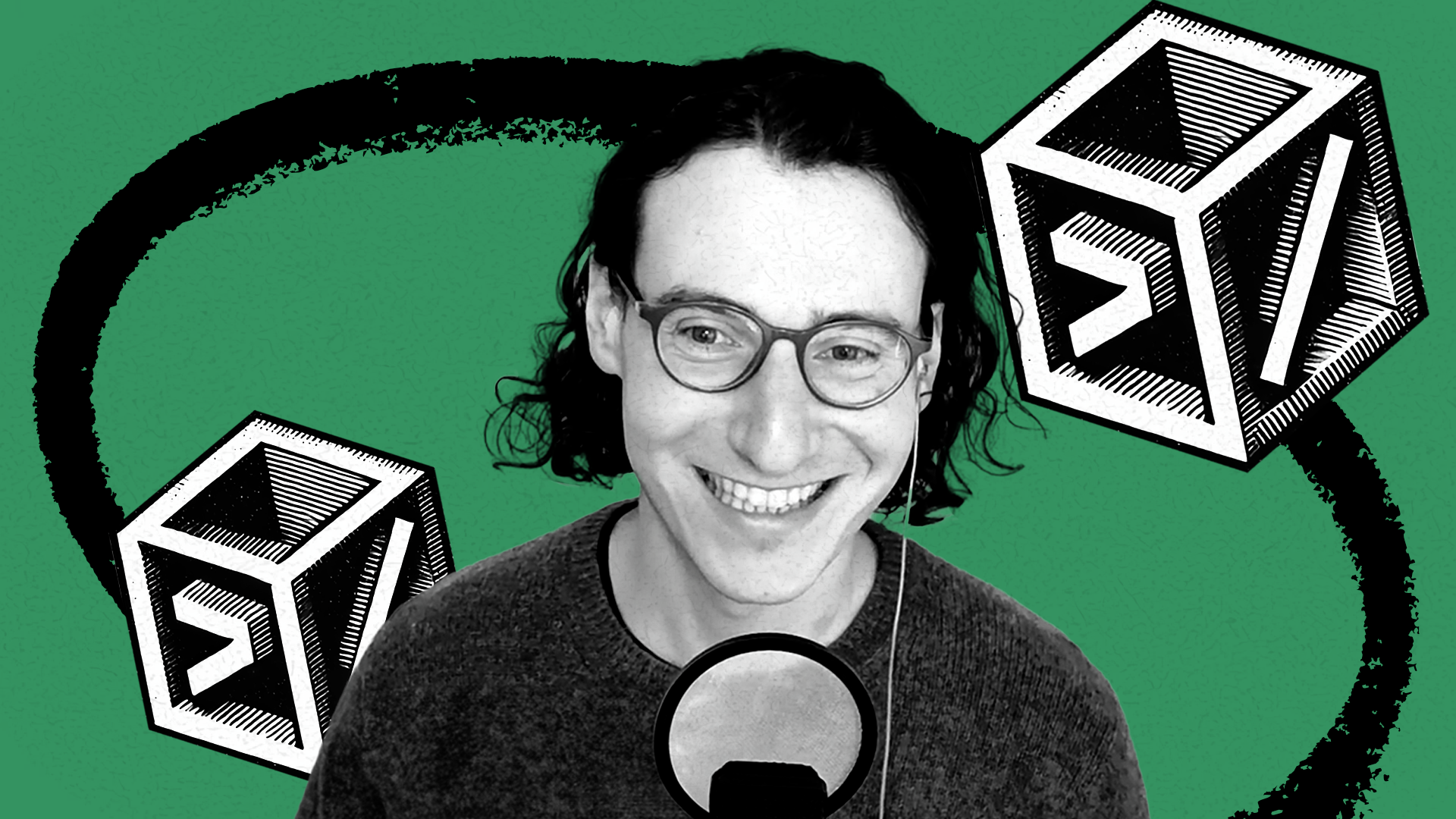
Do 60-minute Coding Tasks in 60 Seconds—With AI
Val Town's Steve Krouse on how far AI has come in the last year
December 4, 2024
TL;DR: Today we’re releasing a new episode of our podcast AI & I. I go in depth with Steve Krouse, the cofounder and CEO of Val Town, a cloud-based platform to write and deploy code from your browser that promotes collaboration and handles a chunk of the backend workflows. We get into how coding can change the way you think and how Steve thinks about positioning Val Town as AI evolves, and do a live demo of Townie as a way to benchmark AI progress. Watch on X or YouTube, or listen on Spotify or Apple Podcasts.
Here’s the most compelling benchmark of AI progress: A task that took 60 minutes a year ago now takes 60 seconds.
In January 2024, researcher Geoffrey Litt and I spent an hour coaxing ChatGPT to build a simple app on this podcast. Nearly 12 months later, Steve Krouse and I built the same app with one prompt in less than minute.
Steve is the cofounder and CEO of Val Town, a cloud-based platform for developers to write, share, and deploy code directly in the browser. In this episode, we used Townie, an AI assistant integrated into Val Town, to build an app that would keep track of time on the podcast, take notes, and generate more questions for the guest.
Townie had generated the app even before Steve could finish describing it on the show, a mark of how much AI has evolved over the last year. As the founder of a growing startup, Steve tells me his contrarian take on why he isn’t focused on the needs of the non-technical AI programmer, betting instead on being the platform sophisticated developers turn to for backend infrastructure. He also tells me how he started programming and how it continues to shape his vision for Val Town. Here is a link to the episode transcript. (Disclosure: I’m a small investor in Val Town.)
This is a must-watch for founders building AI-powered developer tools, and anyone interested in the future of programming.
Watch on X or YouTube, or listen on Spotify or Apple Podcasts.
If you want a quick summary, here’s a taste for paying subscribers:
Sparkle stand-alone
Get 50% off our AI-powered computer organizer—Sparkle
You know what they say: Live an organized life so that your work can be creative and sprawling. That’s why we built Sparkle, an AI tool that cleans up desktops—and keeps them clean. Apply the code BFCM50 to get a head start on 2025.
How programming can change the way you think
Steve happened to go for an afterschool program in middle school where he learned how to code. Through this program, he “fell in love with mathematics, fell in love with programming, and overall felt like a smarter human.” The program was based on the educational programming language Logo, which exposed him to mathematical concepts in an intuitive way. One of the exercises Steve did was instructing a small mechanical robot equipped with a pen—called a Turtle—to draw shapes like squares, circles, and hexagons on a paper. He says, “As you intuit how to do these things, you build up an intuition for what later in life you’ll learn” as the basis for more complex topics. “A couple of years later, when I was learning derivatives, I was like, ‘Oh, the derivative is just the way you're pointing’...I remember in the class…everyone was like, ‘Oh my God, Steve's a genius, he got it so fast,’...but I knew I wasn't born this way, I just had these very powerful experiences that nobody else in the class had.
Years later, at a college hackathon, Steve discovered the scientific principles underlying his formative experience at the coding program. He was introduced to the work of Seymour Papert, a mathematician who happened to study with developmental psychologist Jean Piaget, and who questioned why some children grew up being “bad” at math, but none grew up being “bad” at speaking their native language. “If you're bad at French, it’s because you didn't grow up in France, but we know that if you grew up in France, you’d speak French just fine. [The idea that] some kids are just genetically bad at math didn't make sense to him...his conviction was that those kids—kids who seem like they're bad at math genetically—just didn't grow up in ‘math land.’” Papert was passionate about using computers to create a “virtual math land” to “make kids good at math”—and what he came up with was a programming language designed not to teach kids how to code (largely because there were no jobs for coding back in the sixties), but to “trick kids at being good at math through programming.”
Having actually lived Papert’s theory, Steve “became obsessed with the power of programming languages, programming environments, developer tools not only for the power that they give human beings to create stuff, but the way that they change the way you think and actually make you a smarter human in other aspects of your life.”
A live demo of Val Town’s AI assistant
Steve describes Val Town’s AI assistant Townie as “taking what Dan and Geoffrey did a year ago and automating the steps.” To rebuild the app that Geoffrey and I created on this show, Steve starts by prompting the AI with a description of the app, explaining the idea to the audience as he types: “The idea from your episode with Geoffrey was throw-away, disposable software—it’s just so cheap to make software that we can make an app for this podcast and then never use it again—so there are three parts: one’s a timer, another one is for notes, and then the last one is a ChatGPT integration, where it'll read the notes and generate more questions.” Before Steve could finish describing the idea for the app, Townie had already generated a functional version of the app. We test that the app is working by prompting it to generate questions for a podcast episode with Steve.
How Townie works today—and how Val Town is building infrastructure for AI’s next leap
Under the hood, Townie sends the user’s prompt, and a system prompt created by Val Town, to Claude Sonnet 3.5. Steve explains in more detail:
- Optimize your system prompt. The Val Town team iterated on the system prompt, including in it details about server deployment being handled separately, information about platform-specific bugs, and notes about Val Town’s platform capabilities and integrations, like OpenAI API access. “This system prompt explains where the code that we’re asking [the model] to write is going to live.”
- Keep tabs on model improvements. Steve credits Anthropic’s model as being an “enabler,” highlighting that with previous large language models the output wouldn’t be “this good, or it would take a lot longer.” “We spent a lot of time getting a good system prompt, and then the most important thing that happened was Claude 3.5 Sonnet.”
When it comes to improvements in underlying models, Steve says that he prefers to stay “neutral” to any changes, ensuring that Townie continues to run smoothly on current LLM capabilities, while being agile enough to capitalize on any technological breakthroughs. He recalls how AI code editor Cursor leveraged the capabilities of Sonnet 3.5 when the latter had just launched and thinks that “Val Town is ready for the next model jump, if it happens.” Here’s how Steves thinks about architecting systems at Val Town for this:
- Build adaptable LLM frameworks. According to Steve, building flexible infrastructure to manage different LLMs is valuable, such as “being able to switch models, being able to handle multiple models at a time, add new models in quickly…hav[ing] the infrastructure to tweak the prompt for that model.”
- Develop pricing models that make sense. Val Town is also focused on designing usage-based pricing to address the costs of different models because “these things are really expensive and we just haven't taken the time [to do it] because it's hard to build a whole new pricing model.”
The original version of Townie was a tool-use platform—a framework designed to facilitate interaction between a user and various tools—that mirrored ChatGPT’s user interface, where users interacted with the LLM in a single text-based chat window. After Anthropic launched Artifacts—separate UI windows for displaying content that Claude creates, such as code, diagrams, or documents—the Val Town team realized that it was a much better interface: “We were kind of copying ChatGPT and it was pretty bad, and then Anthropic’s Artifacts launched and we’re like, ‘There we go, that’s the correct UI pattern.’’”
Steve acknowledges that while his instinct is to position Val Town as a disruptor, the rapid pace at which AI is developing suggests that a better strategy is “wait[ing] a month or two, see[ing] what other people do, and copy[ing] it.” They focus on their core business, backend architecture, and for other AI features, they watch players like AI code editor Cursor or full-stack app builder Bolt “come up with these new UI interaction patterns and AI interaction patterns, and then we take the best ones and adopt it.”
The kind of programmer Townie is best-positioned for
Townie has attracted a new breed of non-technical programmers to Val Town. “There are people who really don't know the first thing about coding and come to Val Town and make stuff like this in a minute or two, and their mind is blown and they're so excited and that's amazing,” Steve says. Even though he’s tempted to expand Val Town’s user base to non-technical programmers, he is choosing to focus on the company’s core mission of building a platform for professionals. “I think there's a whole class of people who are allergic to code…they don't even want to know it exists…and Val Town is not the product for those people. The product for those people is Claude Artifacts or Github Spark.”
Steve explains that an alternate path for the company would be to pivot to being a full-stack app development tool, like “Shopify for SaaS apps,” but they’re choosing not to go down that road because even though “it seems simple…it’s just so much more complicated than everybody thinks,: Instead of having a “bad version” of “front end and back end and monitoring and errors and logging and databases and database migrations and database backups,” he would rather “do fewer things, but do them really sharply and better…we could become just the functions of service piece for a lot of people.”
Choosing depth over breadth in the race to define the future of programming
Steve explains that he chose to focus on developing Val Town as a function as a service platform—one that allows users to create apps without the complexity of building the infrastructure associated with launching an app—because it was a persistent problem he faced as a programmer. “I always hated how complicated backend stuff is, and there are three dozen tools that I've used over the years trying to make my life easier on the backend—and I never found one that was good enough.” As the pace of AI picks up, this is how he thinks about running Val Town:
- Position your startup in a strategic niche. Offering specialized backend services differentiates Val Town from frontier AI companies, like Anthropic, whose Artifacts feature is a Townie competitor. “I think these LLM companies don't want to run their own function as a service…they're going to want to partner with someone, and that's the outsize dream that they partner with us to help them run backend compute for their customers somehow.”
- Leverage the benefits of staying small. Steve believes that being a small team that can leverage AI to work faster is a key advantage for Val Town. The team is working on adding capabilities for users to do multi-file edits on the platform, and because “the whole team has to be on board with [most decisions], we can't add more people to make it go faster—more people would honestly make it go slower.”
You can check out the episode on X, Spotify, Apple Podcasts, or YouTube. Links and timestamps are below:
- Watch on X
- Watch on YouTube
- Listen on Spotify (make sure to follow to help us rank!)
- Listen on Apple Podcasts
Timestamps:
- Introduction: 00:00:55
- How programming changes the way you think: 00:03:24
- Building an app in less than 60 seconds: 00:11:22
- How Val Town’s AI assistant works: 00:17:19
- Steve’s contrarian take on the non-technical AI programmer: 00:23:05
- The nuances of building software that isn’t deterministic: 00:33:38
- How to design systems that can capitalize on the next leap in AI: 00:39:05
- What gives Val Town a competitive edge in a crowded market: 00:40:47
- The power of small, dense engineering teams: 00:47:34
- How Steve is positioning Val Town in a strategic niche: 00:52:26
What do you use AI for? Have you found any interesting or surprising use cases? We want to hear from you—and we might even interview you. Reply here to talk to me!
Miss an episode? Catch up on my recent conversations with star podcaster Dwarkesh Patel, LinkedIn cofounder Reid Hoffman, a16z Podcast host Steph Smith, economist Tyler Cowen, writer and entrepreneur David Perell, founder and newsletter operator Ben Tossell, and others, and learn how they use AI to think, create, and relate.
If you’re enjoying my work, here are a few things I recommend:
- Subscribe to Every
- Follow me on X
- Subscribe to Every’s YouTube channel
Thanks to Rhea Purohit for editorial support.
Dan Shipper is the cofounder and CEO of Every, where he writes the Chain of Thought column and hosts the podcast AI & I. You can follow him on X at @danshipper and on LinkedIn, and Every on X at @every and on LinkedIn.
We also build AI tools for readers like you. Automate repeat writing with Spiral. Organize files automatically with Sparkle. Write something great with Lex.
Find Out What
Comes Next in Tech.
Start your free trial.
New ideas to help you build the future—in your inbox, every day. Trusted by over 75,000 readers.
SubscribeAlready have an account? Sign in
What's included?
-
Unlimited access to our daily essays by Dan Shipper, Evan Armstrong, and a roster of the best tech writers on the internet
-
Full access to an archive of hundreds of in-depth articles
-
-
Priority access and subscriber-only discounts to courses, events, and more
-
Ad-free experience
-
Access to our Discord community





Comments
Don't have an account? Sign up!